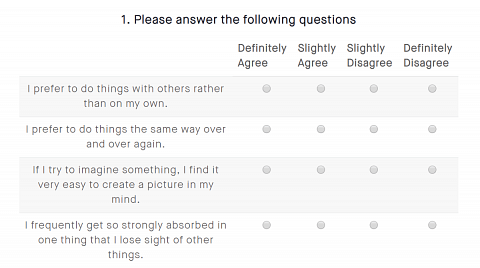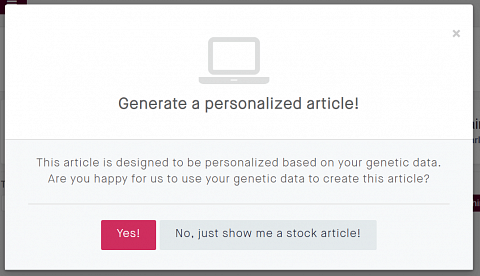-
Genetics of Autism and Mathematical Ability
review on October 12, 2018
by Rebecca Fishwick

At a Glance
Summary
I was impressed by the transparency of Sano Genetics, and by their dynamic consent model, which allowed me to pick and choose who would have access to my genetic and survey data for each study I chose to be a part of.
While there was no monetary reimbursement for participating, I was able to view my results for the different studies, and to access articles about completed studies. This gave me a good idea of the information I was contributing, and how it might benefit research into human health and longevity.
Full Review
Sano Genetics is an online service connecting people with digital genetic data to researchers. The company is headed by CEO Patrick Short, COO Charlotte Guzzo, and CTO Will Jones, all three of whom are researchers at the Wellcome Trust Sanger Institute and University of Cambridge.
Opportunity Expectations
On the Sano Genetics website, I learned that the platform would allow me to share my data with researchers on a case-by-case basis. This would allow me to participate in the latest research, while maintaining transparency, choice, and ownership of my genetic data.
I could view demos of three of the research projects that I could participate in, which included an Autism Spectrum Quotient, Math Quotient, and Low-Cost DNA Sequencing offered by Sano Genetics.
I saw that Sano Genetics would allow me to be a part of global research contributing to human health and longevity, while having the final say on how my data is used. They employed a “dynamic consent model”, meaning that I could choose when and how to share my data for each project I chose to participate in. My data would be encrypted, and they would ask my permission before sharing it. In return for my data, I would receive personalized reports about the research I chose to participate in.
Signup Experience
It was easy to sign up to Sano Genetics. I was required to create a username and password, and give an email address. I had to tick a couple of boxes: one agreeing to the terms and conditions, the other stating I was over 16 years old. Soon after, I was sent a confirmation email.
The terms and conditions and privacy policy were pretty extensive. Amongst the discoveries I found were that my personal data would not be transferred outside the European Economic Area (EEA), meaning it would remain protected by GDPR.
I then was asked to fill out a medical history form, which was neither very intrusive nor comprehensive, and took less than a minute to fill out. For each question I answered, I could choose whether I wanted to share this information only with the researchers running the study (in this case Sano Genetics), or all the researchers interested in the study.
After completing this initial survey, I was taken to my dashboard, where I could upload a photo, and upload genetic data from 23andMe or AncestryDNA (there were guides to uploading from each).
After uploading a .txt file of my 23andMe data, I was asked whether I wanted this information to be available to researchers, and whether I would allow researchers to contact me with follow-up questions. I was impressed by just how dynamic their dynamic consent model really was!
The Opportunity
I could participate in the different research projects by going to the “Participate” tab. Here, I could browse the different studies, and choose which ones I wanted to participate in.
Each study was in a questionnaire format, and I contributed my DNA data along with my answers, which would allow researchers to find a correlation between my genetic data and my predispositions.
For the purposes of this review, I participated in an Autism Quotient study, which was comprised of 50 questions, and had been developed by researchers from the Autism Research Centre at the University of Cambridge. This was not a diagnostic test, but was designed to measure autistic traits.
I was presented with 50 statements, such as “I prefer to do thigs with others rather than on my own.” For each statement, I was asked to indicate how strongly I agreed or disagreed with it (shown below).

A snippet from the Autism Quotient questionnaire.
At the end of the questionnaire, I could choose whether I wanted to share my data only with the researchers conducting the study, or all researchers interested in the study (shown below).

Consent options for who could use my data.
I was then given my Autism Quotient score out of 50 (a higher number meant more autistic traits), and was asked whether I wanted to allow the Autism Research Centre at the University of Cambridge to access my genetic data. I could also choose to tweet my score, if I wanted!
Platform Experience
From the dashboard, I could choose to “Start Tour”, which showed me around the features of the platform. In addition to the “Participate” tab, which showed the studies that were currently running and which I could participate in, there was an “Explore” tab.
Here, I could view articles about the studies that had already been completed. These articles could be personalized using my genetic data (shown below).

Article personalization options.
Though I opted to personalize the articles, this feature didn’t seem to be working properly yet. Clicking on the highlighted rsIDs (numbers denoting a specific location in the human genome) was meant to show me which genetic variants I had, but I was told only “You have the genotype [#] at position [rsID]. You have a rare genotype! Does this sound like you?” without any sort of explanation of what my genotype was.
Still, for the people who took part in these studies, it would be interesting to read about the discoveries.
In the “Settings” tab, I found I could view the surveys I had taken part in. I could also choose to email or delete all the genetic and survey data from my account.
There was also an “FAQ” tab, which included questions such as “What information do you keep about me?” Again, I was pleased by Sano Genetics’ transparency, and the fact that I retained ownership of my data.
Summary
I was impressed by the transparency of Sano Genetics, and by their dynamic consent model, which allowed me to pick and choose who would have access to my genetic and survey data for each study I chose to be a part of.
While there was no monetary reimbursement for participating, I was able to view my results for the different studies, and to access articles about completed studies. This gave me a good idea of the information I was contributing, and how it might benefit research into human health and longevity.


